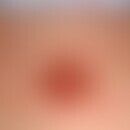Synonym(s)
HistoryThis section has been translated automatically.
Zillikens, 1996; Chen, 1996
DefinitionThis section has been translated automatically.
Very rare (about 100 cases have been described so far), chronic, bullous autoimmune skin disease with subepithelial cleavage and neutrophilic (eosinophilic) infiltration of the dermo-epidermal junctional zone.
You might also be interested in
Occurrence/EpidemiologyThis section has been translated automatically.
Very rare. So far, less than 100 case descriptions have been published worldwide.
EtiopathogenesisThis section has been translated automatically.
Autoimmune disease; target antigen is a 200 kDa protein (p200) localized under the lamina lucida. The NC1 domain of the laminin-gamma1 chain has been identified as the major target antigen. It is probably an adhesion molecule of the cutaneous basement membrane. The protein binds laminin to type IV collagen. It is produced by dermal fibroblasts and by keratinocytes.
Some patients also exhibit reactivities against BP230, BP180, laminin 332 or type VII collagen. This phenomenon is referred to as"epitope spreading".
ManifestationThis section has been translated automatically.
Predominantly 5-6 years of age. Men are more frequently affected than women.
Clinical featuresThis section has been translated automatically.
Severely pruritic, extensive deep red patches and plaques and large bulging blisters, sometimes aspect of erythema multiforme (see Fig.), on the trunk and extremities. Less commonly, vesiculous clinical picture. Mucosal involvement (oral and genital mucosa) in 20% of patients. Healing without scarring.
An association with psoriasis is present in 1/3 of patients.
The extent to which esophageal carcinomas are associated with the clinical picture requires further investigation.
LaboratoryThis section has been translated automatically.
In the laboratory, an IgG antibody against the 200 kDa laminin-gamma1 is detected by immunoblotting. The antibodies against the pemphigoid AK BP180 and BP 230; collagen VII, laminin 332 are not found.
HistologyThis section has been translated automatically.
Direct ImmunofluorescenceThis section has been translated automatically.
In lesional and perilesional skin, linear deposits of IgG and C3 along the dermo-epidermal junction zone.
Further investigations can be performed by indirect immunofluorescence on human saline split skin with the patient serum, showing IgG and C3 deposits at the dermal bottom of the artificial split.
TherapyThis section has been translated automatically.
A standard therapy of anti-p200 pemphigoid cannot be proposed yet. Rapid response to immunosuppressive therapy, e.g. azathioprine 1.0-1.5 mg/kg bw/day p.o. combined with systemic glucocorticoids such as prednisone, initially 1.0-1.5 mg/kg bw/day, later reduction to 20-10 mg/day, has been described.
Alternatives to Azathioprine are:
- Ciclosporin A 250 mg/day p.o.
- Mycophenolate mofetil 2g/day p.o.
- Dapsone 100 mg/day p.o. (often not sufficiently effective)
- Tetracycline 1.5 g/day (little effective!)
Progression/forecastThis section has been translated automatically.
Note(s)This section has been translated automatically.
Laminin gamma 1 is a glycoprotein of the extracellular matrix, which lies below the lamina lucida and is involved in the construction of the basement membrane. Since the IgG antibodies of the patients in the immunoblot with keratinocyte extract show a reaction with a 200kDa protein, the autoantigen of this disease was first designated as p200 before it was identified as laminin gamma 1.
LiteratureThis section has been translated automatically.
- Chen KR et al (1996) Coexistence of psoriasis and an unusual IgG-mediated subepidermal bullous dermatosis: identification of a novel 200-kDa lower lamina lucida target antigen. Br J Dermatol 134: 340-346.
- Commin MH et al.(2016) Clinical and immunological features and outcome of anti-p200 pemphigoid. Br J Dermatol 175:776-781.
- Goetze S et al,(2016) Anti-p200/laminin γ1 pemphigoid associated with metastatic esophageal cancer. J Eur Acad Dermatol Venereol doi: 10.1111/jdv.13983.
- Rose C et al (2007) Histopathology o anti-p200 pemphigoid. Am J Dermatopathol 29: 119-124.
Séméria L et al (2022) Anti-p200 pemphigoid mimicking erythema multiforme. JAAD Case Rep 21:157-159.
- Shimanovich I et al (2003) The autoantigen of anti-p200 pemphigoid is an acidic noncollagenous N-linked glycoprotein of the cutaneous basement membrane. J Invest Dermatol 121: 1402-1408
- Yasuda H et al (2004) Two cases of subepidermal blistering disease with anti-p200 or 180-kD bullous pemphigoid antigen associated with psoriasis. Dermatology 209: 149-155
- Zillikens D et al (1996) A novel subepidermal blistering disease with autoantibodies to a 200-kDa antigen of the basement membrane zone. J Invest Dermatol 106: 1333-1338.
Incoming links (1)
Pemphigoid antibodies;Outgoing links (10)
Azathioprine; Ciclosporin a; Dadps; Epitope spreading; Glucocorticosteroids systemic; Laminin; Mycophenolate mofetil; Prednisone; Psoriasis (Übersicht); Tetracycline;Disclaimer
Please ask your physician for a reliable diagnosis. This website is only meant as a reference.





